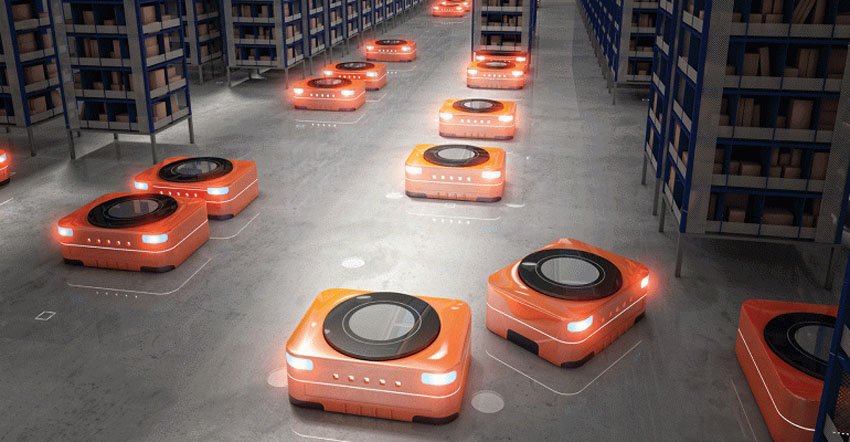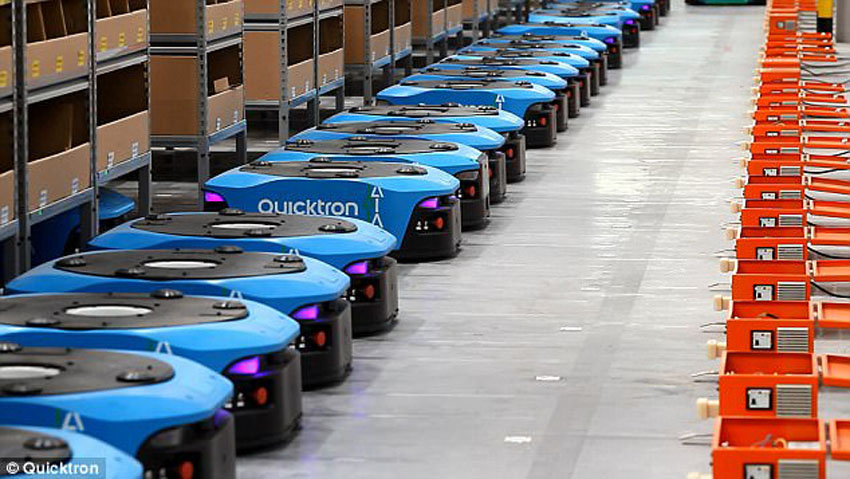
Industrial coworking engineers of the Don State Technical University (DGTU) will create sorting robots for the Rostov branch of the Russian Post. The other day the signing of an agreement on cooperation between the university and the state monopoly. The project of the automated sorting complex will receive financing and will help to increase the efficiency of the distribution of parcels. The name of the group of cars selected corresponding - "Botolion".
With the help of the Russian Post robots, it intends to automate the work of the main sorting center, through which parcels from the Rostov, Volgograd, Astrakhan, Tambov, Kursk, Lipetsk, Belgorod and Voronezh regions, as well as from the Krasnodar Territory and the Republic of Adygea pass. In this area, selected to launch a pilot project, about 5 thousand parcels per day are processed. Now all this is done by hand, the only help is conveyors and loaders. But soon a piece of work can be shifted onto the backs of smart machines.
 One of the new centers of the Russian Post. 1200 people-sorters work at this center.
One of the new centers of the Russian Post. 1200 people-sorters work at this center.The success of the project should help increase the speed of the center and reduce costs. Robots team develops Garazh. To implement the project, they analyzed the experience of Amazon and Puma. According to the current idea, the Post of Russia cars will have sensors on the body, at the expense of which they will determine when the load is put on them. Then they will automatically weigh it, check the track number and go to the desired container assigned to the region to put the package there. The same weight sensors allow devices to quickly respond to the loss of the package, giving a signal. And when the battery charge comes to an end, the robot will independently head for the charging station.
According to the creators, 6 out of 10 robots will function simultaneously while the rest are charging. During the shift, one robot will be able to process about 5,000 parcels weighing up to 20 kg each.
In order for the machines not to bump into each other, information about their movement will be transmitted to the server, where the self-learning neural network will choose the best route for them. In DGTU say:
The robotized system will minimize human involvement in the sorting process. You only need to properly place the parcels on the platform and monitor the health of the robots.
Unlike conveyor systems, the use of robots is less energy consuming, easily scaled and relocated to other premises.

Work began in April of this year, and it is expected that the first prototype of the Botollon will be presented in Garazhe by the end of September. The decision on the economic efficiency of the project and the required number of robots will be made on the basis of pilot tests. Let's hope that the “Mail of Russia” will not have a repetition of the story with the delivery drone for 1.2 million rubles, which crashed on its first flight.
Where the legs grow
In fact, in the DGTU, they plan to take over the development of their western (or even, rather, eastern) colleagues. Such systems have long used Aliexpress and Amazon. They allow them to save hundreds of millions of dollars, processing parcels many times faster than people, and almost avoiding mistakes.
For example, in July 2017, a similar system was launched at a warehouse in Huiyang, in the southern province of Guangdong in China. Sixty robots connected to Wi-Fi, there are responsible for storing and transporting hundreds of thousands of goods placed on 3 000 square meters. They bring things to people, and they stand still and simply pack and direct the parcels. The warehouse is owned by T-mall, owned by Alibaba. They say that due to robots, the performance in this warehouse has increased threefold.
 Alibaba robots (T-mall)
Alibaba robots (T-mall)So that the devices do not collide with each other, there are lasers on each side that determine the distance to the nearest object. Each robot can move at a speed of 1.5 m / s, moving up to 600 kg of weight. From one charge such “rumba” continuously works up to 8 hours. Usually, the Chinese in the warehouse had to do 28 thousand steps in 7.5 hours to find and send 1500 products. With the help of new robots, the same employee for the same time can distribute 3000 goods, and make only 2563 steps.

The number of online purchases in China has quadrupled from 2012 to 2017. Now the country has more than 8,000 fast delivery companies delivering 32 billion (!) Packages in a year - 23 packages per person. To stand out among the competitors in this business, you need to be more accurate and faster than the rest. Therefore, some delivery centers also decided to start up robots. The experience of one of them, from Shengong, will be especially useful for the “Post of Russia”. In fact, this is exactly what they want to create at DGTU.
An entire army of yellow robots works in a warehouse of 1.3 square kilometers - sorting up to 200,000 parcels per day. They determine the destination of the parcel through scanning the track code, and are mistaken several times less often than people-sorters. People still need to remove things from the conveyor and careful installation of them on the "roof" of the robot, but here they also will not be a problem to replace them.
The "sex" that droids move around looks the best. Metal trunk with holes on the sides. Each of these holes is assigned a specific address where the delivery truck goes. For a person there are no signs, the warehouse employee will have no idea where to put this or that package. But the robot knows perfectly well for which cell the package on his back is intended for, and he understands how to get there the fastest. The company managing the warehouse says that sorting with the help of robots saves about 70%, even taking into account the cost of electricity.
Well, the most advanced system in the world works on Amazon. To develop its American company began in 2009. Then Jeff Bezos wrote a letter to the shareholders of the company, declaring the war "Muda". This is a Japanese term meaning "loss" or "waste." For Amazon, this meant that the company should work as efficiently as possible.

To speed up the development of its robots, in 2012 Amazon bought their manufacturer, Kiva Systems, for $ 775 million. Now this company has been renamed to Amazon Robotics. In 2010, several hundred test machines worked in the warehouses of the American retail giant. In 2016 - already 40 thousand. Now, in June 2018, there are more than 80 thousand of them. In terms of design and functionality, they are almost identical to those used by Alibaba (who copied from whom is understandable by the implementation date). They drive up under the mobile shelves, and bring them to the staff when the order becomes necessary to the goods in one of the cells.
The company has enough robots capable of moving heavy shelves or individual parcels. But the exact devices that can replace human hands and eyes when choosing individual products, yet. Therefore, every year in July, Amazon holds a competition among universities in Japan. It gives $ 250 thousand to the team that offers the most efficient robot for their warehouses. Such a robot should be able to select individual products, and put them in a basket (like “Hvatayka” slot machines somewhere in the park, only an order of magnitude faster and more accurately). The winner is determined by how many things he successfully selected and folded. The objects that they need to choose, the Japanese teams are given only 30 minutes before the start of the competition. But so far, these robots are not as accurate and versatile as the company would like, and before installing them in warehouses, as Amazon says, it’s probably many more years.
The pace of production robotization is accelerating around the world. According to the International Federation of Robotics, the average density of robots in the world increased from 66 pieces to 10 thousand working people in 2015 - to 74 in 2017. In the first place is South Korea (from 631 robots to 10 thousand workers), in the second - Singapore (488), in the third - Germany (309). The top ten also includes Japan, Sweden, Denmark, USA, Italy, Belgium and Taiwan. In Russia, there are only three robots for 10 thousand working people. Perhaps the Botolión will change this over time?
PS We at Pochtoy.com help with purchases in American stores and deliver your packages from the USA to Russia. From $ 8.99 per pound. And if after
registration to enter the code Geektimes, you write $ 7 on your account.